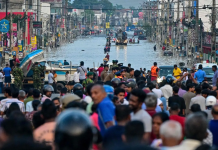By Cui Yan, People’s Daily
What kind of vitality can art bring to the countryside?
Shuangcheng village in Pingchang county, southwest China’s Sichuan province is where the famous oil painting Father was created.
The village, leveraging the influence of this masterpiece produced by the painter Luo Zhongli, has built itself into a hub of rural tourism with its sound ecology and rich heritage. It is recognized as a provincial-level demonstration village for the revitalization of rural culture.
The story of Shuangcheng village is exactly a great example of how art can boost rural revitalization.
Art is an expression of beauty that lights up a better life. Injecting art elements into the construction of “beautiful villages” not only brings a new look to the rural area, but also paves the way for people to live a more aspiring life.
Dongziguan village in Fuyang district, Hangzhou of east China’s Zhejiang province, turned old houses in disrepair into folk houses with local features. Together, the renovated residences look like a Chinese ink painting that well depicts the unique charm. The used-to-be “hollow village” that once suffered a big loss of young workforce is finally getting back the hustle and bustle.
Shangwei village in Longhua district of Shenzhen, south China’s Guangdong province was once bothered by trash dumps and sewage flowing into the river. Today, timeworn walls have turned into “drawing papers” covered in graffiti, and the whole village is immersed in an artistic and tranquil atmosphere.
Zhongxin village in Youyang Tujia and Miao autonomous county, southwest China’s Chongqing municipality, advanced a “toilet revolution” with aesthetic elements, which made renovated public restrooms both pragmatic and good-looking.
Rural revitalization calls for both physical and cultural development. Art can nurture the mind of people and shape the values of villages.
In Xingyi village of Lijiang, southwest China’s Yunnan province, mural artist Liu Zhicheng is presenting aesthetics to villagers via delicate wall paintings. These wall paintings have raised the villagers’ pursuit and aspiration for beauty and inspired many children to learn drawing.
Today, rural art festivals are presenting the charm of aesthetics to residents, and art workshops offer a place for children to receive aesthetic education through fun activities. Besides, some villages have also hosted rural galas and singing competitions, which reactivated cultural resources and enhanced villagers’ sense of belonging.
Leading rural cultural construction with art will better vitalize cultural development in the countryside and enrich the life of villagers.
Art is also a “golden key” that can stimulate potential growth drivers, thus expanding the space for rural economic development. It is bringing more possibilities to rural areas.
As a well-preserved ancient village, Zecheng village in Zuoquan county, north China’s Shanxi province has experienced rapid development thanks to its scenic resources and cultural legacy.
Zuoquan county has built a base for outdoor sketching that features artistic elements, attracting many students and artists. The county has also hosted art exhibitions and developed study tour programs.
These new business forms boosted local tourism and cultural consumption and created jobs for villagers, which proves the concept of “lucid waters and lush mountains are invaluable assets,” expands villagers’ income and promotes rural revitalization.
Artistic creation betters the living environment in rural areas, art activities enrich the cultural life of rural residents, and art-related business forms create development opportunities. The countryside in the new era has become more beautiful with the decoration of art.
As various types of art practices are carried out in rural areas, art will constantly pave the path to cultural revitalization. It is believed that art will edify more rural residents and better their lives in the countryside.



















